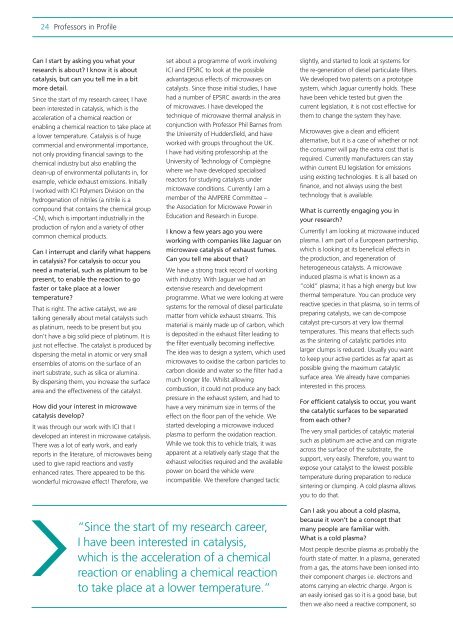Spring 2012 Issue - University of Central Lancashire
Spring 2012 Issue - University of Central Lancashire
Spring 2012 Issue - University of Central Lancashire
You also want an ePaper? Increase the reach of your titles
YUMPU automatically turns print PDFs into web optimized ePapers that Google loves.
24 Pr<strong>of</strong>essors in Pr<strong>of</strong>ile<br />
Can I start by asking you what your<br />
research is about? I know it is about<br />
catalysis, but can you tell me in a bit<br />
more detail.<br />
Since the start <strong>of</strong> my research career, I have<br />
been interested in catalysis, which is the<br />
acceleration <strong>of</strong> a chemical reaction or<br />
enabling a chemical reaction to take place at<br />
a lower temperature. Catalysis is <strong>of</strong> huge<br />
commercial and environmental importance,<br />
not only providing financial savings to the<br />
chemical industry but also enabling the<br />
clean-up <strong>of</strong> environmental pollutants in, for<br />
example, vehicle exhaust emissions. Initially<br />
I worked with ICI Polymers Division on the<br />
hydrogenation <strong>of</strong> nitriles (a nitrile is a<br />
compound that contains the chemical group<br />
-CN), which is important industrially in the<br />
production <strong>of</strong> nylon and a variety <strong>of</strong> other<br />
common chemical products.<br />
Can I interrupt and clarify what happens<br />
in catalysis? For catalysis to occur you<br />
need a material, such as platinum to be<br />
present, to enable the reaction to go<br />
faster or take place at a lower<br />
temperature?<br />
That is right. The active catalyst, we are<br />
talking generally about metal catalysts such<br />
as platinum, needs to be present but you<br />
don’t have a big solid piece <strong>of</strong> platinum. It is<br />
just not effective. The catalyst is produced by<br />
dispersing the metal in atomic or very small<br />
ensembles <strong>of</strong> atoms on the surface <strong>of</strong> an<br />
inert substrate, such as silica or alumina.<br />
By dispersing them, you increase the surface<br />
area and the effectiveness <strong>of</strong> the catalyst.<br />
How did your interest in microwave<br />
catalysis develop?<br />
It was through our work with ICI that I<br />
developed an interest in microwave catalysis.<br />
There was a lot <strong>of</strong> early work, and early<br />
reports in the literature, <strong>of</strong> microwaves being<br />
used to give rapid reactions and vastly<br />
enhanced rates. There appeared to be this<br />
wonderful microwave effect! Therefore, we<br />
set about a programme <strong>of</strong> work involving<br />
ICI and EPSRC to look at the possible<br />
advantageous effects <strong>of</strong> microwaves on<br />
catalysts. Since those initial studies, I have<br />
had a number <strong>of</strong> EPSRC awards in the area<br />
<strong>of</strong> microwaves. I have developed the<br />
technique <strong>of</strong> microwave thermal analysis in<br />
conjunction with Pr<strong>of</strong>essor Phil Barnes from<br />
the <strong>University</strong> <strong>of</strong> Huddersfield, and have<br />
worked with groups throughout the UK.<br />
I have had visiting pr<strong>of</strong>essorship at the<br />
<strong>University</strong> <strong>of</strong> Technology <strong>of</strong> Compiègne<br />
where we have developed specialised<br />
reactors for studying catalysts under<br />
microwave conditions. Currently I am a<br />
member <strong>of</strong> the AMPERE Committee –<br />
the Association for Microwave Power in<br />
Education and Research in Europe.<br />
I know a few years ago you were<br />
working with companies like Jaguar on<br />
microwave catalysis <strong>of</strong> exhaust fumes.<br />
Can you tell me about that?<br />
We have a strong track record <strong>of</strong> working<br />
with industry. With Jaguar we had an<br />
extensive research and development<br />
programme. What we were looking at were<br />
systems for the removal <strong>of</strong> diesel particulate<br />
matter from vehicle exhaust streams. This<br />
material is mainly made up <strong>of</strong> carbon, which<br />
is deposited in the exhaust filter leading to<br />
the filter eventually becoming ineffective.<br />
The idea was to design a system, which used<br />
microwaves to oxidise the carbon particles to<br />
carbon dioxide and water so the filter had a<br />
much longer life. Whilst allowing<br />
combustion, it could not produce any back<br />
pressure in the exhaust system, and had to<br />
have a very minimum size in terms <strong>of</strong> the<br />
effect on the floor pan <strong>of</strong> the vehicle. We<br />
started developing a microwave induced<br />
plasma to perform the oxidation reaction.<br />
While we took this to vehicle trials, it was<br />
apparent at a relatively early stage that the<br />
exhaust velocities required and the available<br />
power on board the vehicle were<br />
incompatible. We therefore changed tactic<br />
slightly, and started to look at systems for<br />
the re-generation <strong>of</strong> diesel particulate filters.<br />
We developed two patents on a prototype<br />
system, which Jaguar currently holds. These<br />
have been vehicle tested but given the<br />
current legislation, it is not cost effective for<br />
them to change the system they have.<br />
Microwaves give a clean and efficient<br />
alternative, but it is a case <strong>of</strong> whether or not<br />
the consumer will pay the extra cost that is<br />
required. Currently manufacturers can stay<br />
within current EU legislation for emissions<br />
using existing technologies. It is all based on<br />
finance, and not always using the best<br />
technology that is available.<br />
What is currently engaging you in<br />
your research?<br />
Currently I am looking at microwave induced<br />
plasma. I am part <strong>of</strong> a European partnership,<br />
which is looking at its beneficial effects in<br />
the production, and regeneration <strong>of</strong><br />
heterogeneous catalysts. A microwave<br />
induced plasma is what is known as a<br />
“cold” plasma; it has a high energy but low<br />
thermal temperature. You can produce very<br />
reactive species in that plasma, so in terms <strong>of</strong><br />
preparing catalysts, we can de-compose<br />
catalyst pre-cursors at very low thermal<br />
temperatures. This means that effects such<br />
as the sintering <strong>of</strong> catalytic particles into<br />
larger clumps is reduced. Usually you want<br />
to keep your active particles as far apart as<br />
possible giving the maximum catalytic<br />
surface area. We already have companies<br />
interested in this process.<br />
For efficient catalysis to occur, you want<br />
the catalytic surfaces to be separated<br />
from each other?<br />
The very small particles <strong>of</strong> catalytic material<br />
such as platinum are active and can migrate<br />
across the surface <strong>of</strong> the substrate, the<br />
support, very easily. Therefore, you want to<br />
expose your catalyst to the lowest possible<br />
temperature during preparation to reduce<br />
sintering or clumping. A cold plasma allows<br />
you to do that.<br />
“Since the start <strong>of</strong> my research career,<br />
I have been interested in catalysis,<br />
which is the acceleration <strong>of</strong> a chemical<br />
reaction or enabling a chemical reaction<br />
to take place at a lower temperature.”<br />
Can I ask you about a cold plasma,<br />
because it won’t be a concept that<br />
many people are familiar with.<br />
What is a cold plasma?<br />
Most people describe plasma as probably the<br />
fourth state <strong>of</strong> matter. In a plasma, generated<br />
from a gas, the atoms have been ionised into<br />
their component charges i.e. electrons and<br />
atoms carrying an electric charge. Argon is<br />
an easily ionised gas so it is a good base, but<br />
then we also need a reactive component, so

















